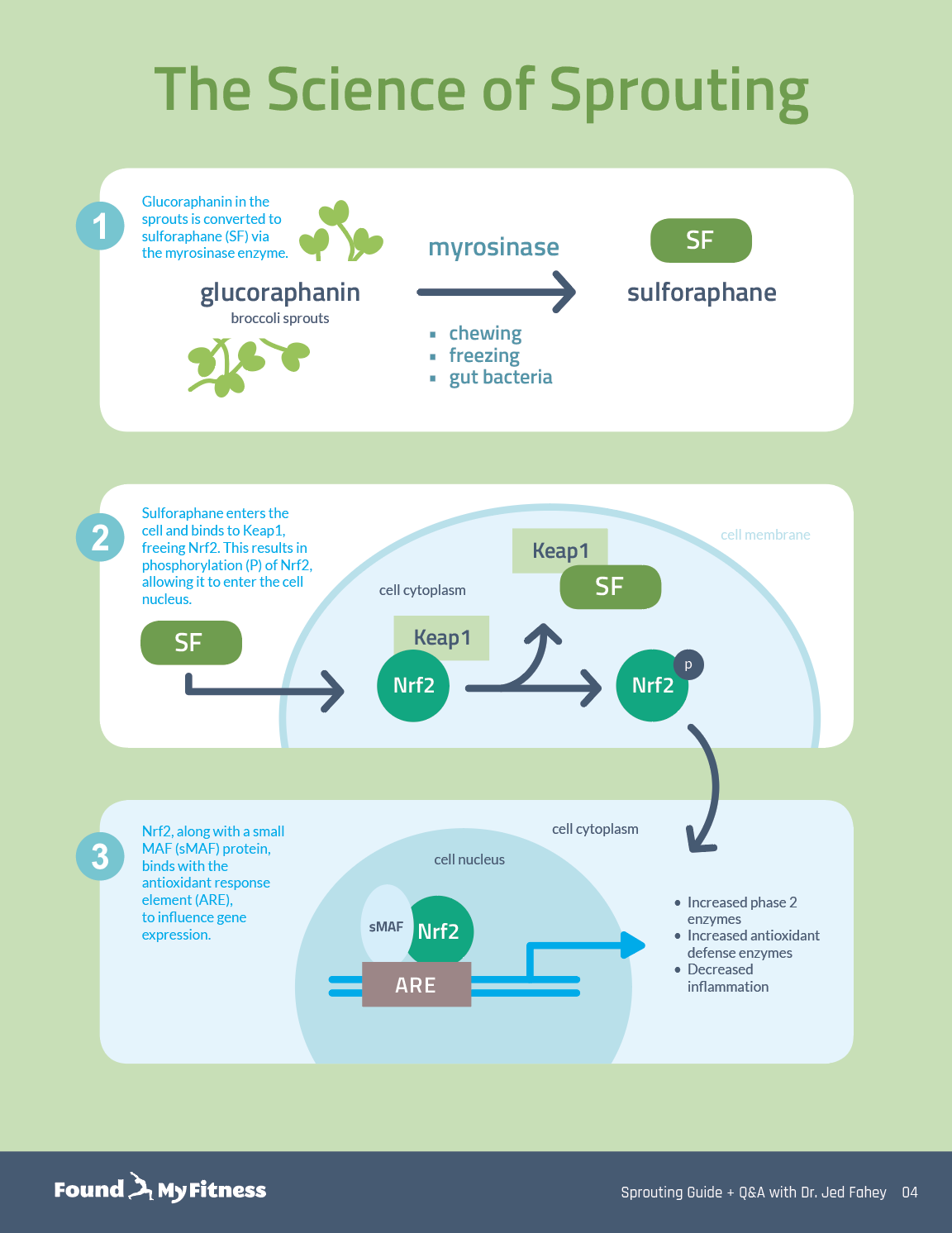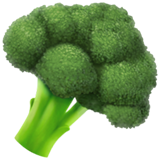Is moringa a viable alternative to broccoli sprouts? | Jed W. Fahey
Enter your email to get our 15-page guide to sprouting broccoli and learn about the science of chemoprotective compount sulforaphane.
Broccoli sprouts are concentrated sources of sulforaphane, a type of isothiocyanate. Damaging broccoli sprouts – when chewing, chopping, or freezing – triggers an enzymatic reaction in the tiny plants that produces sulforaphane.

Get the full length version of this episode as a podcast.
This episode will make a great companion for a long drive.
Moringa is a tropical plant that exerts a wide range of beneficial health effects. A growing body of evidence indicates that moringin, an isothiocyanate compound derived from moringa, may help prevent or even treat a variety of chronic health conditions, including cancer, diabetes, and autism. In this clip, Dr. Jed Fahey discusses the beneficial health effects of moringa.
- [Dr. Patrick]: So let's move on to some of these questions relating to the alternatives to broccoli sprouting.
So the first question is, "In previous discussions around sulforaphane and broccoli sprouts moringa has come up, it's been mentioned to have similar benefits." This person says that their family has six moringa trees in Mexico and they consume large handfuls of moringa leaves daily in their smoothie. "Is there any research to indicate the most bioavailable way to consume moringa, for example the leaves, dried and powered, frozen leaves, etc.?"
[Dr. Fahey]: Yeah. I was glad to see that question. And I saw someone else made some comment about that picture of you and me in your podcast, one of us was holding a bag of moringa seeds. And they were right, that's...we had been talking about it. As you put your coat on to leave. That was... God, that was forever ago. Three years ago?
[Dr. Patrick]: Four.
[Dr. Fahey]: Four, yeah.
[Dr. Patrick]: Yeah. That was when I was pregnant, but didn't tell anyone, no one knew. I was pregnant with my son. Anyways.
[Dr. Fahey]: I remember learning of that when we met you in San Diego.
And so I was glad to see the question because indeed moringa leaf powder is sort of my go-to. I am on the Scientific Advisory Board of Kuli Kuli, which makes moringa leaf powder. So I've got a free supply of moringa leaf powder from them, but it also means that I know a good bit now about the quality and the supply chain of dried moringa leaves.
They're... If you live in the tropics, they're ideal because you can grow the trees anywhere. If you don't live in the tropics, fresh leaves are not nearly as good. They don't freeze and travel very...or they don't refrigerate and travel very well at all. So dried, powdered leaves are great. Which is why a number of companies have been able to make a business of selling dried, powdered leaves in this country.
We did a few papers, we've done a number of papers, on moringa. We never had any funding for it really, but...or not any to speak of because this is not a tropical country and the funding agencies aren't as interested in it. But one of the things we did is experimented with moringa teas and found that both hot and cold teas are...you know, are great. And it sort of modifies that sharp taste of the moringa leaf powder.
In terms of efficacy, the isothiocyanate for moringa, it's called moringin. And there is a long scientific name I won't bore you with. But in many assays it's even better than sulforaphane, and in others it's not as good. You know, it depends on the assay and so on. But because of that, I am very bullish about moringa's possibilities. On the other hand, because it has not been nearly as heavily researched, you know, there's far less we can say about it from a clinical perspective. But, and the person who asked this question would appreciate this, it's been grown and eaten, moringa leaves have been grown and eaten, for centuries, literally, by populations in the tropics around the world very safely.
So the safety of moringa leaf powder...or in moringa leaves is absolutely well-documented. There aren't many clinical studies for specific indications, but they're coming because the interest has really grown in them.
So I do use moringa lead powder and make moringa tea all the time, and I recommend it. I think there is the... I copied down the question that was...one of the questions that was asked about moringa and that person said they'd been cold brewing one teaspoon of powder in one cup of water for 30 minutes to great effect, "I feel amazing after taking it." We are working... I should use that as a launching point and say we are working on that sort of comment, "I feel amazing after taking it." That's obviously an anecdote, I appreciate it and I see it all the time. We're trying with some clinical studies we're putting together now to better document those sorts of statements. You know, "I feel amazing and I have way more energy," are the ones I hear all the time. So we're going to be trying to document those anecdotes that are attributed to both broccoli sprouts and supplements and moringa with some hard evidence.
So anyway, yeah, they're safe to eat and good for you, and I'd encourage their use.
[Dr. Patrick]: Two comments, Jed. One just my own anecdote, I've been putting moringa powder from Kuli Kuli into my smoothies and I also feel great. But I also feel great without the moringa powder and the smoothie. So, but the interesting thing I have noticed with moringa powder, and this has been repeatable, I've been wearing a continuous glucose monitor for, oh, about three years now and the...
[Dr. Fahey]: Hardcore, hardcore.
[Dr. Patrick]: So hardcore, you have no idea. But my typical smoothie is some...a little bit of kale and blueberries, avocado, and collagen powder. And adding the moringa powder in there, the moringa powder... The blueberries, it doesn't really raise my glucose levels much. So the smoothie itself without the moringa powder, you know, brings me to about postprandial glucose, like, 105. And the moringa powder consistently lowers that by, I don't know, 7 to 10 units. Don't have any idea what's going on mechanistically, I'm sure someone is going to study it. And there's been some interesting research on type 2 diabetes. And I don't want to go there because we have to get to safety, which is a really important chunk of this Q&A. But I thought that was an interesting anecdote.
The second comment is there was a live question. Sorry. Go ahead.
[Dr. Fahey]: Absolutely. So you can't say something like that and not have me interrupt. Yeah. So the biggest medical indication for moringa leaf powder is going to be...is, I think, diabetes. And that has...that is under...
[Dr. Patrick]: You're kidding?
[Dr. Fahey]: No. No, no, I'm not. That is under active investigation. Blood glucose control.
[Dr. Patrick]: You're kidding?
[Dr. Fahey]: No. No, we have a review that shows...there are...there were six, not all good studies at all, and they were all tiny, showing an effect of moringa leaves or moringa leaf powder. We can talk about that another time. I've even talked about it on a podcast.
[Dr. Patrick]: So my N of 1 was, you know, actually probably real.
[Dr. Fahey]: Very interesting. Now if all 100 million of your viewers are wearing glucose monitors, we can put them together and have a study.
A test used in laboratory medicine, pharmacology, environmental biology, and molecular biology to determine the content or quality of specific components.
An essential mineral present in many foods. Iron participates in many physiological functions and is a critical component of hemoglobin. Iron deficiency can cause anemia, fatigue, shortness of breath, and heart arrhythmias.
Byproduct of a reaction between two compounds (glucosinolates and myrosinase) that are found in cruciferous vegetables. Isothiocyanates inhibit phase I biotransformation enzymes, a class of enzymes that transform procarcinogens into their active carcinogenic state. Isothiocyanates activate phase II detoxification enzymes, a class of enzymes that play a protective role against DNA damage caused by reactive oxygen species and carcinogens. Examples of phase II enzymes include UDP-glucuronosyltransferases, sulfotransferases, N-acetyltransferases, glutathione S-transferases, and methyltransferases.
A chemical that causes Parkinson's disease-like symptoms. MPTP undergoes enzymatic modification in the brain to form MPP+, a neurotoxic compound that interrupts the electron transport system of dopaminergic neurons. MPTP is chemically related to rotenone and paraquat, pesticides that can produce parkinsonian features in animals.
Relating to the period after eating. Postprandial biomarkers are indicators of metabolic function. For example, postprandial hyperglycemia is an early sign of abnormal glucose homeostasis associated with type 2 diabetes and is markedly high in people with poorly controlled diabetes.
An antibody that plays key roles in immunity. Secretory IgA is the most abundant antibody in the mucosal immune system, accounting for nearly 20 percent of serum immunoglobulin. It is crucial in protecting the intestinal epithelium from toxins and pathogenic microorganisms.
An isothiocyanate compound derived from cruciferous vegetables such as broccoli, cauliflower, and mustard. Sulforaphane is produced when the plant is damaged when attacked by insects or eaten by humans. It activates cytoprotective mechanisms within cells in a hormetic-type response. Sulforaphane has demonstrated beneficial effects against several chronic health conditions, including autism, cancer, cardiovascular disease, diabetes, and others.
A metabolic disorder characterized by high blood sugar and insulin resistance. Type 2 diabetes is a progressive condition and is typically associated with overweight and low physical activity. Common symptoms include increased thirst, frequent urination, unexplained weight loss, increased hunger, fatigue, and impaired healing. Long-term complications from poorly controlled type 2 diabetes include heart disease, stroke, diabetic retinopathy (and subsequent blindness), kidney failure, and diminished peripheral blood flow which may lead to amputations.
Volatile organic compound. An organic chemical that has a high vapor pressure at ordinary room temperature.
Attend Monthly Q&As with Rhonda
Support our work

The FoundMyFitness Q&A happens monthly for premium members. Attend live or listen in our exclusive member-only podcast The Aliquot.
Sulforaphane News
- Broccoli seed extract with a sulforaphane precursor reduced common cold symptom days in healthy adults.
- Sulforaphane-rich broccoli sprout extract modestly lowers fasting blood sugar in some people with prediabetes, perhaps due to variations in gut microbiota and individual metabolic traits.
- Sulforaphane, derived from broccoli, activates Nrf2, mitigating age-related skin changes and boosting the antioxidant defense system in mice.
- Sulforaphane from broccoli sprouts shows promise in preventing Alzheimer's disease – boosting memory and enhancing mitochondrial function in mice.
- Breathwork enhances endogenous antioxidant enzyme activity to counter oxidative stress.






